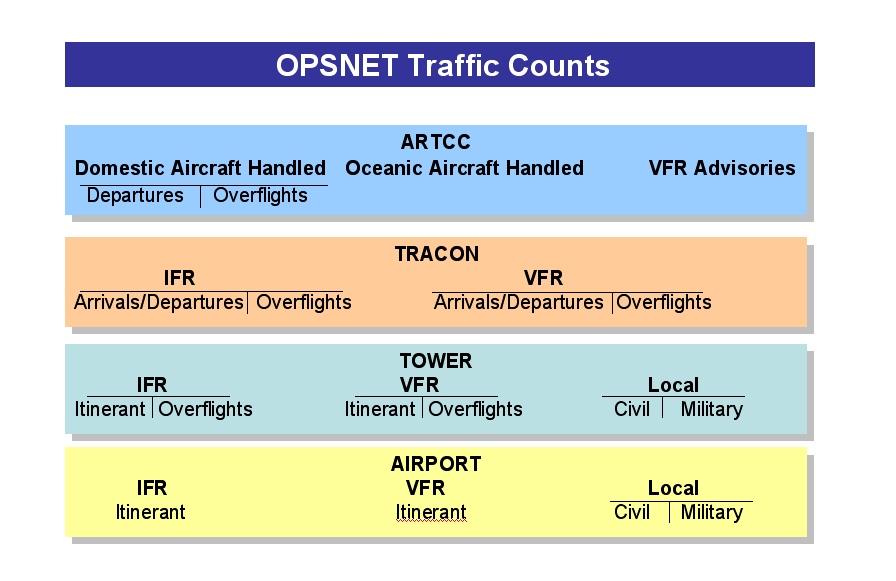Operations Network (OPSNET)
Contents |
Overview
The Operations Network (OPSNET) is the official source of NAS air traffic operations and delay data. The data collected through OPSNET is used to analyze the performance of the FAA's air traffic control facilities.
The data sent daily to OPSNET can be viewed on the FAA Operations & Performance Data Web site.
To access next day OPSNET data, users require a login. Without a login, users can access finalized OPSNET Operations and Delay data for each month on the 20th of the next month; i.e., June data are available on July 20. OPSNET records the following information and data:
- Airport Operations are arrivals and departures at an airport. The Airport Operation Count is a measure of activity at FAA-funded airports, including Federal Contract Towers (FTC). This activity reports IFR itinerant and VFR itinerant operations (arrivals and departures), and local operations at the airport as reported by Air Traffic Control Towers (ATCTs). It does not include overflights.
- Tower Operations are all take-offs and landings at the airport as well as other aircraft worked by the Tower. This activity reports IFR and VFR itinerant operations (arrivals and departures), IFR and VFR overflights, and local operations worked by the tower.
- TRACON Operations is a count maintained by the TRACON and includes itinerant operations at all airports and overflights worked by the TRACON. This activity reports IFR and VFR itinerant operations and overflights worked by the TRACON. For more information, see TRACON Operations.
- Total Terminal Operations are total traffic worked at any facility based on the functions at the facility. If a facility has a tower and a TRACON present, the Total Terminal operations would be a sum of the Tower Operations and the TRACON operations for that facility. This data is primarily used for funding and staffing the facility as well as maintaining operating procedures.
- Center Aircraft Handled includes total aircraft handled by ARTCCs and CERAPs. Data is retrieved by departures and overflights for domestic and oceanic flights.
- Facility Information provides information about each air traffic control facility, such as facility name and type, region, state, hours of operation, etc.
- Delays provides information about the reportable delays provided daily through FAA's Air Traffic Operations Network (OPSNET). For more information, see OPSNET: Delays.
For a list of facility classifications reported by OPSNET, please see Facility Classifications.
Data Sources and Update Cycle
From October 22, 2007 and in accordance with FAAO 7210.55E (now replaced by FAAO 7210.55F), all ATC facilities with the exception of flight service stations (FSS) are required to record OPSNET data and transmit data to the ATO System Operations, Quality Assurance (QA) office at the David J. Hurley Air Traffic Control System Command Center (ATCSCC) daily. The ATCSCC QA then processes the data and stores them into the OPSNET database.
In 2008 the FAA revised the procedures and methodologies for reporting and tabulating both air traffic counts and delays in the Operations Network (OPSNET). The updated delay reporting rules attribute delays to both the facility that caused the delay impact, and the facility at which the delay occurred. The revised OPSNET operations reporting began July 1, 2008, and the revised delay reporting began October 1, 2008. Historical OPSNET operations data dating back to FY 1989 and delay data back to FY 1999 have been converted to be consistent with the revised reporting standards and are available in the ASPM OPSNET module.
OPSNET operations and delay data are updated daily for the previous day.
Data Availability
The general public and other users without a login can access finalized OPSNET operations and delay data 20 days after the end of each month. Customers with a login can access preliminary data from the previous day’s activity.
Change History
In 2008 the FAA revised the OPSNET methodology for reporting and tabulating air traffic counts and delays. The new methodology for reporting air traffic counts improved the integrity and accuracy of traffic count reports. Legacy OPSNET data dating back to FY 1990 have been standardized with the revised air traffic count reporting rules.
The revised delay reporting methodology includes several important modifications:
- The new reporting rules combine arrival and enroute delays into one category called “Airborne”. All airborne delays are now allocated to the ARTCC or TRACON where the delay occurred. In addition, the new reporting system also presents the number of airborne delays by destination airport.
- Departure delays resulting from Traffic Management Initiatives (previously referred to as TMS delays) are still allocated to the facility causing the delay but are displayed as “TMI To”. A column labeled “TMI From” has been added to display the number of TMI delays for the facility at which they occurred.
- The FAA now reports delays for aircraft which accumulate 15 minutes or more holding delay throughout the entire route of flight. Previous reporting rules recorded cumulative holding within each separate FAA facility. Each holding segment for aircraft accumulating a delay of 15 minutes or more is recorded as a delay.
To allow for compatible comparison analysis, legacy OPSNET delay data dating back to FY 2000 have been standardized to meet the revised delay definitions. Airborne delays that were reported prior to October 1, 2008, and which were allocated to airports and reported as “arrival delays” are now allocated to the ARTCC or TRACON that reported the delay.
System Documentation
- FAA Order JO 7210.3W Facility Operation and Administration establishes the procedures for tabulating and reporting facility air traffic counts in OPSNET.
- FAAO 7210.55E Operational Data Reporting Requirements establishes additional reporting requirements and procedures and defines responsibilities for collecting air traffic activity counts and delay data through OPSNET.


